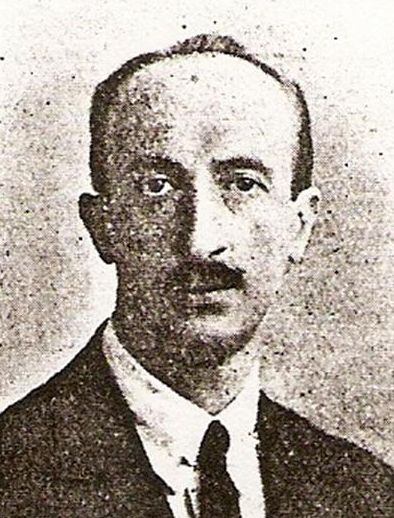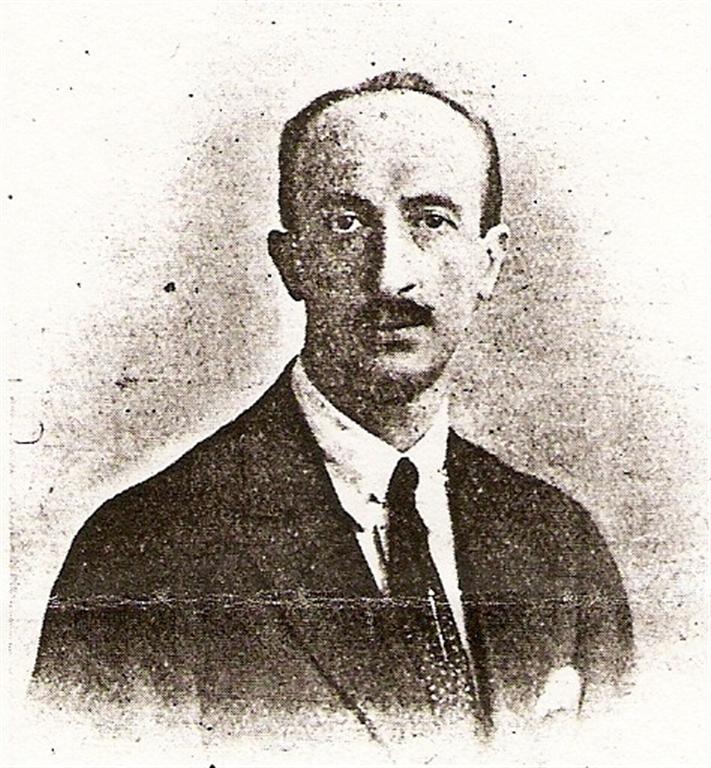PIONEERRESPOND
Giuseppe GIDINO <1882> - 1930
 | |
| aka | G. Gidino |
| nationality | |
| occupation | recording engineer/inventor |
| birth | .... <1882>, ......, ITALY |
| baptism | |
| death | 26 May 1930, Hendon, Middlesex, ENGLAND (48y) (GRO 3a/387) |
| burial | |
| marriage | on .. Oct/Nov/Dec 1917, St. Giles, ENGLAND
 Alice HUNTER Alice HUNTER b. .... <1878>, ........ |
PARENTS
| father | |
| mother | |
| children |
LIFE
recorder ODEON/FONOTIPIA
recorder FAVORITE between 1906 and 1908 / 1911-1912 (j?/k/l)
In 1908-1910 joined COLUMBIA PHONOGRAPH COMPANY GENERAL, London
In 1915 recording in London for minor company
Famous Records (see p. 2185/2194 Andrews article in TMR no. 75 Autumn 1988)
1919 Managing Director of British Gramophone Motors Ltd., London
(FRAGMENTA, p. 46-47 and 52)
Giuseppe Gidino (in: "A Fonotipia Fragmenta" p. 965/969) recording engineer for ODEON: 1904 (Berlin), then joined FAVORITE (Hannover-Linden): Gidino must have been FAVORITE'S j/k/l expert, who recorded late 1906/early 1907 and perhaps also afterwards in 1911-1912).
In 1908 he joined the COLUMBIA PHONOGRAPH COMPANY GENERAL (LONDON) and left in 1910. After a short flying-stint he took up his old occupation as a recording engineer, serving a number of European and British companies.
In The Sound Wave of June 1915, p. 226, 228 appeared an interview with Gidino, which must have taken place in June 1915 in London.
My first wanderings, he said, brought me to Berlin, which, for the first few days, seemed to me 'The Tower of Babel'. Not one word of that guttural language could I understand, and almost gave up in despair, but, deciding to make the best of a bad job, I went to work to learn the 'Kultur' speech. I had many amusing experiences during the first six months, but these are too numerous and, perhaps, too trivial to mention.
One day I happened to meet A. Michaelis, director of the 'FONOTIPIA' of Milan, who offered me the management of that company in Berlin, and I may claim to be the first man to control that record in Germany. After the first three months, however, I came to the conclusion that a recorder's work was of a more congenial and interesting nature, with plenty of travelling. The more I thought about it, the more resolved I became, but as recording in those days was virtually a close secret, I was compelled to undertake my own education in the art. By way of commencement I succeeded in persuading my landlady to dismantle my bedroom (I was then too poor to afford a separate sitting room), leaving me only a bed and the barest necessities of life, so that I might be in a position to utilise all the remaining space for the purposes of a workshop. I then started in earnest. Rising at six o'clock, so as to be at my place of business by eight o'clock, and returning home at eight p.m., from which hour until midnight I worked at the construction of a recording machine, and after some time I managed to erect one - a freak, it is true - but, nevertheless, a machine that suited my purpose sufficiently well. I also contrived a recording sound-box, and after a great struggle with waxes, with these primitive instruments, and the help of some friends with guitar and mandoline, I began my career as recorder."
"Not an easy matter, by any means!" interpolated our representative.
"You're right! It was not an easy start!" rejoined Mr. Gidino. "I was able to record certainly, but for a long time I could get neither shell nor prints. But success came at last, and with such satisfactory results that Mr. Prescott engaged me as recorder for the 'ODEON'. Naturally, my work improved with experience, and from the 'ODEON' I went to the 'FAVORITE' in Hanover." [ca. 1906/1907]
Then the idea possessed Mr. Gidino to come to England to learn English and to see our country for himself; so he packed up and arrived here just seven years ago [ca. 1908].
After two years with the COLUMBIA Company [ca. 1908-1910], however, he contracted aeroplane fever, so prevalent at that time, and for some years followed the bent of his inclination in this direction. In this connection he had hazardous and laughable experiences. The details of one of these he related as follows:
I went to Paris to sell a patent which I had taken out for quick rising (then much desiderated), and was dealing with a view to forming a 100.000 francs syndicate. When lunching with one of the would-be capitalists, he invited me to Issy-les-Molineaux, to inspect a new machine, and on the way there, in the course of conversation, said: Naturally, as you are going to build an aeroplane, you must know how to fly. Which make do you fly?. This was very disconcerting, inasmuch as I had never piloted an aeroplane in my life. I could not well tell him that I had only had a few hops at Park Royal, for I felt certain that either I must fly or, the 100.000 francs would take wings of their own. In as nonchalant a manner as possible I thereupon reply, I fly a Bleriot monoplane, in the hope that he would have a Farman. Imagine my discomfort when he exclaimed, Oh, right! That is just what I am trying.You will try it for me, especially as it has a Gnome motor. Tableau! We eventually arrived at the flying ground, where I dressed and jumped on the machine. I carefully inspected the system of starting and stopping the engine, also the different levers, and then gave the order to start the engine in the sincere hope that it would never start. Luck was against me, because it started immediately to turn round and splash me with castor oil. I took the precaution of going at half speed along the ground, to find out all there was to know about the machine, and when I did find out that nothing would go wrong to help me out of trouble, I put on full speed. A quick jump and a quick run, then I pulled the lever and up I went - at least I guessed I was going up, as I did not get the bumping I had when I was on the ground. After a delightful spin in the air I thought it time to come down, but how to get down I did not know. I did something which brought me down tail first, and saved my skin by throwing myself on to the left wing. The motor came backwards and took away the seat. Lucky escape! I went on in this business until I promised my mother that I would never fly again, and there this chapter of my history ends..
Of course, this little aeroplane interlude has nothing to do with records or sound reproduction, but we have in it an indication of Mr. Gidinos versatility and adventurous disposition. Returning to London he resumed his gramophone vocation, in connection with the BEL CANTO COMPANY, and afterwards with the KALLIOPE COMPANY, for whom he proceeded on a recording mission in Austria and Servia. Finally he attached himself to Blum and Co., Ltd., for whom, as we know, he has done most excellent work. He is now at the call of his country to fight in the cause of national freedom and international civilisation against the barbarism and military despotism of Germany.
Besides recording Mr. Gidino can manufacture from the wax up to the finished record, and that with his own hands - not, as he said laughingly, with my tongue like some I could mention!
See: e-mail Paul Cleary 13/5/2005
See also: A Fonotipia Fragmenta, p. 43, 46-47.
PIONEER label (source: Arthur Badrock via Paul Cleary)
matrix numbers are followed bij "gg" [Giuseppe Gidino] under the labels.
These are probably from Sound Recording Company matrices
Date? ...........................
In 1919 Managing Director of British Gramophone Motors Ltd. (in: AFF, p. 52)
Giuseppe Gidino filed several applications for patents:
- GB191768 Gidino, G. July 21, 1921
- Patent number: 1543997 Filing date: Nov 12, 1924 Issue date: June 30, 1925
- Patent number: 1778109 Filing date: Jan 6, 1930 Issue date: Oct 14, 1930
(Giuseppe Gidino of Oxford, England, Assignor of one-half to Stewart Cole of London, England).
- CIPO-Patent 302180 inventor: Giuseppe Gidino / Stewart Cole
NOTES
- Favorite: the story of an independent German record company (1904-1914) by Hugo Strötbaum (in: The Lindström Project. Contributions to the history of the record industry / Beiträge zur Geschichte der Schallplattenindustrie. Vol. 2 (editors: Pekka Gronow & Christiane Hofer). Gesellschaft für Historische Tonträger, Wien 2010. ISBN 978-3-9500502-1-9
- A FONOTIPIA FRAGMENTA. A History of the Societa Italiana di Fonotipia - Milano 1903-1948 by Frank Andrews (Historic Singers Trust, 2002), p. 47
(this (revised) edition originally appeared as a series of articles in The Talking Machine Review - International between June 1976 and December 1977)
- Seventy-eight Revolutions Per Minute in the Levant. A Discography of Favorite's Oriental Recordings by Hugo Strötbaum (in: De Turcicis Aliisque Rebus, Commentarii Henry Hofman dedicati, M. Vandamme (ed.). Utrecht 1992, 227 pages (ISBN 90-393-0291-x))
- Favorite: 1904-1914. Oftewel het relaas van de ongrijpbare q-serie by Hugo Strötbaum (in: De Weergever, 17e jaargang No. 6 - november-december 1995, pp. 243-265)
- De Geschiedenis van Favorite: 1904-1914, deel 2. De opbouw van het katalogusnummer (=facenumber); achtergrondinformatie over de firma 'Favorite' by Hugo Strötbaum (in: De Weergever, 18e jaargang No. 1 - januari-februari 1996, pp. 2-22)
- De Geschiedenis van Favorite: 1904-1914, deel 3. Voorlopig overzicht van de opnamesessies van Favorite, 1904-1914 by Hugo Strötbaum (in: De Weergever, 18e jaargang No. 2 - maart-april 1996, pp. 51-71)
- Favorite Revisited by Hugo Strötbaum
- Favorite: Grammofoninnspillingene og artistene by Vidar Vanberg (Norsk grammofonplatehistorie 17. Eget forlag, Oslo 2007. ISBN 978-82-91962-03-0)
- Favorite Records: A Discography by Frank Andrews and Bill Dean-Myatt (CLPGS Reference Series No. 8, 2010 with CD-ROM entitled Favorite Records in the United Kingdom: A history and catalogue reonstruction.
- Schallplatten-Fabrikation by Otto Birckhahn (in: Berliner Tageblatt: Technische Rundschau of 24 Feb 1909, p. ?)
- Deutsche Schallplatten in Amerika (in: Zeitschrift für Instrumentenbau of 21 Mar 1906, p. ?)
COMPANIES & LABELS
THANK YOU
Paul Cleary




